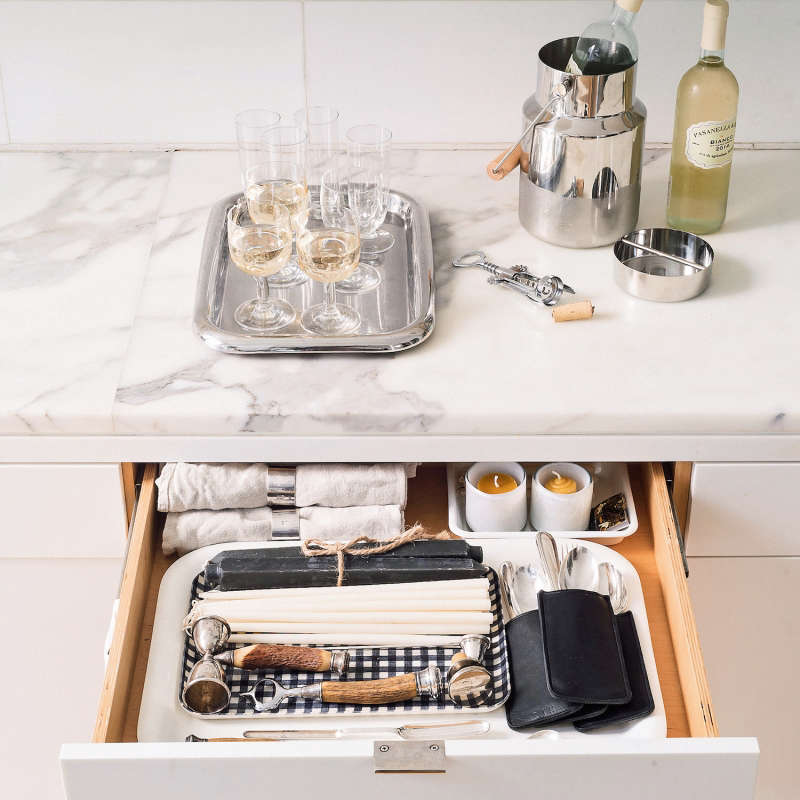The humble can of paint: In the right hands it can transform your home, enlivening dull facades and reviving tired, old surfaces. But in the wrong hands, it just leaves your home looking sloppy. Hiring the right painter requires thorough research and a rigorous vetting process. It also helps to ask the right questions.
In part 2 of my original feature: Expert Advice: How to Hire a Truly Great Painter for Your Home, we once again turn to my trusted painter, Nigel Costolloe, owner of Catchlight Painting, in Newton, MA. As part of the interview process, Nigel notes, pointed inquiries and open-ended questions can reveal a lot about a company’s practices. Here is a list of common painting pitfalls, along with questions that the savvy homeowner can ask in order to avoid them:
N.B.: Featured image by deVol: Kitchen of the Week: An Imposing English Manor, Updated for Modern Family Life.

1. Inadequate prep.
Every potential painter will agree with you that prep is the most important part of the job. But how can you determine the true-believer from the salesman? The answer is in the details.
Ask any potential painter to provide a thorough explanation of the kind of prep they recommend for your job and why. For exteriors, ask if they recommend scraping, sanding, or a full grinding. Why? Look for contractors that attend to the different surfaces and areas of your home such as trim versus siding or walls. Do they ask if you want nicks and cracks filled? Do they note areas of buildup that may need to be stripped? The more you both talk details, the better. You may decide that you’d rather save money by skipping some cosmetic prep, but discussing all the options will assure the painter better understands and meets your expectations. Finally, ask if they have a contingency to perform more prep if their initial efforts don’t meet your expectations.
2. Subcontracting.
Even though it is illegal in many states to subcontract to someone within the same field, disreputable or overextended paint companies will sometimes subcontract your project to another paint company. Often the subcontracted company has no idea what you agreed to pay the original contractor. This means that they must cut costs to make the project viable, which for you, guarantees a substandard job. Furthermore you have no idea who is on your property or what kind of background check they have had.
Of course no one will admit to this practice and may be insulted if you ask. Instead inquire how long the owner’s employees have worked with the company. And ask if the same crew will be there throughout the project.

3. Poorly trained workers, or worse….
Ask how the company trains its workers. Nigel notes that many companies offer their employees little-to-no training “except by yelling at them when they do something wrong.” A company that is able to offer detailed information about how they train their employees demonstrates that they have made an investment in these individuals to insure quality work.
Also ask about which background checks they perform on their employees. Any parent who wants to chaperone their child’s field trip has to have a CORI/SORI check. Painters working around your children should have no less. Also listen for mention of drug tests. You certainly don’t want someone under the influence to be on top of a ladder in your yard or in your home. Finally if you have lead paint in your home, you want to hear that they test employees for lead levels to ensure safety precautions are taken.
4. Improper oversight or lack of communication.
Ask for the name of the project manager. Ascertain if he/she will be on site and if this person will be available for daily check-ins via text, phone, and email.
5. Bad weather.
For exterior paint jobs: Inquire after the company’s policies for dealing with less than ideal conditions. Not just rain, but all kinds of weather—excessive heat, moisture, or dryness—can effect your paint job, as will overnight temperatures under 35 degrees. Listen for reassurances that they will not paint in these conditions.

6. Lead paint.
Ask about practices for dealing with lead paint. Listen for mention of proper protection, safety and cleanup, and for reassurances that a lead-certified overseer will be on site when removing lead paint. It’s the law.
7. Cheap paint.
Inquire after the recommended brand of paint. Painters looking to cut costs might be tempted to use lower quality paint. Nigel was once hired by a homeowner after the client caught a previous painter decanting cheap paint into Benjamin Moore cans!
8. Too many or too few coats of paint.
Ask for specifics on the number of coats they suggest. Paint is supposed to be permeable, so more isn’t always best. On the other hand too little paint can chip or leave areas of your home exposed to the elements.
9. The wrong kind of paint.
Listen for specifics about the type of environment your paint will be exposed to. For example, are you painting a moist bathroom, hi-traffic floor, surface with old horse hair plaster, or are you painting over oil paint? For conditions like these, ask your painter if they recommend specialized paint. Why or why not?

10. Unforeseen issues.
Ask about options for expanding the project. Stripped paint can reveal problems unforeseen in the bid process, such as rot. Or, again, you may decide you want more detailed prep. Make sure that the company builds a bit of flexibility into their schedule.
11. Fire.
Exterior painters using power tools can overload old wiring. Ask about fire safety protocols. Making sure the company has fire extinguishers on site, and access to a hose will give you peace of mind.
12. Lack of accountability for a bad job.
Inquire after the company’s warranty policy. Sometimes it can take a year or two for problems to manifest. Make sure the company’s warranty extends at least two years and covers not just the paint, but also the labor/application. Nigel, who notes that warranties can be a valuable “feedback loop” for his company, offers a 3-year warranty on his work.
Finally, ask the owner to tell you about a time when they made a mistake on a job and what they did to fix it. Everyone, including great contractors, makes mistakes. How they fix mistakes, will tell you a lot about their accountability.
Now that you’ve hired a reputable company, its time to choose a color:
- Palettes & Paints: A New Line of Luxe Paints from Cassandra Ellis
- 13 Boutique Paint Companies from Around the World
- 9 New Paint Colors from Farrow & Ball: A Color Field Trip with Zio and Sons
N.B.: This post is an update; the original story ran on October 21, 2o19.




Have a Question or Comment About This Post?
Join the conversation (1)